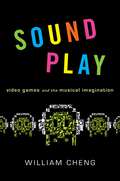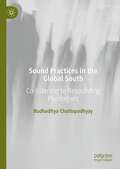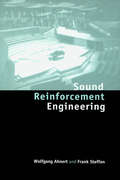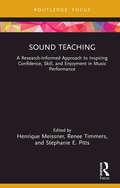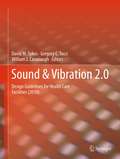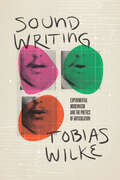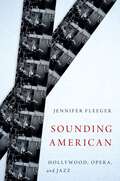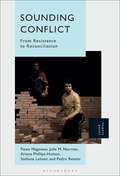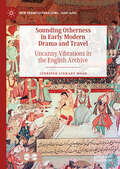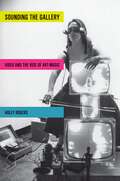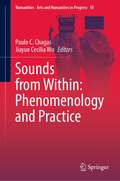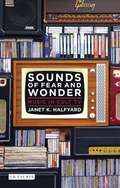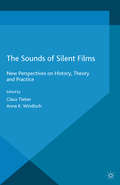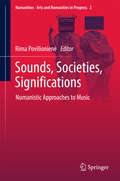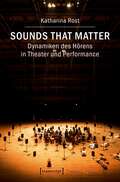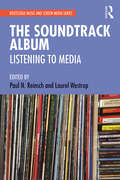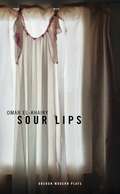- Table View
- List View
Sound Play: Video Games and the Musical Imagination (Oxford Music / Media)
by William ChengVideo games open portals to fantastical worlds where imaginative play and enchantment prevail. These virtual settings afford us considerable freedom to act out with relative impunity. Or do they? Sound Play explores the aesthetic, ethical, and sociopolitical stakes of people's creative engagements with gaming's audio phenomena-from sonorous violence to synthesized operas, from democratic music-making to vocal sexual harassment. William Cheng shows how video games empower their designers, composers, players, critics, and scholars to tinker (often transgressively) with practices and discourses of music, noise, speech, and silence. Faced with collisions between utopian and alarmist stereotypes of video games, Sound Play synthesizes insights across musicology, sociology, anthropology, communications, literary theory, philosophy, and additional disciplines. With case studies spanning Final Fantasy VI, Silent Hill, Fallout 3, The Lord of the Rings Online, and Team Fortress 2, this book insists that what we do in there-in the safe, sound spaces of games-can ultimately teach us a great deal about who we are and what we value (musically, culturally, humanly) out here. Foreword by Richard Leppert Video Games Live cover image printed with permission from Tommy Tallarico
Sound Practices in the Global South: Co-listening to Resounding Plurilogues
by Budhaditya ChattopadhyayThis book develops a comprehensive understanding of the unique sound worlds of key regions in the Global South, through an auto-ethnographic method of self-reflective conversations with prominent sound practitioners from South Asia, Africa, the Middle East and Latin America. The conversations navigate various trajectories of sound practices, illuminating intricate sonic processes of listening, thinking through sounds, ideating, exposing, and performing with sound. This collection of conversations constitutes the main body of the book, including critical and scholarly commentaries on aural cultures, sound theory and production. The book builds a ground-up approach to nurturing knowledge about aural cultures and sonic aesthetics, moving beyond the Eurocentric focus of contemporary sound studies. Instead of understanding sound practices through consumption and entertainment, they are explored as complex cultural and aesthetic systems, working directly with the practitioners themselves, who largely contribute to the development of the sonic methodologies. Refocusing on the working methods of practitioners, the book reveals a tension between the West’s predominant colonial-consumerist cultures, and the collective desires of practitioners to resist colonial models of listening by expressing themselves in terms of their arts and craft, and their critical faculties.Conversations with: Clarence Barlow, Sandeep Bhagwati, Rajesh K. Mehta, Sharif Sehnaoui, Ximena Alarcón Díaz, Hardi Kurda, Mario de Vega, Luka Mukhavele, Khyam Allami, Cedrik Fermont, Khaled Kaddal, David Velez, Juan Duarte, Youmna Saba, Abdellah M. Hassak, Mariana Marcassa, Amanda Gutiérrez, Syma Tariq, Alma Laprida, Siamak Anvari, Mohamad Safa, Debashis Sinha, Zouheir Atbane, Constanza Bizraelli, Jatin Vidyarthi, Joseph Kamaru, Surabhi Saraf, Isuru Kumarasinghe, Hemant Sreekumar.
Sound: A Reader in Theatre Practice (Readings in Theatre Practice)
by Ross BrownBrown explores relationships between sound and theatre, focusing on sound's interdependence and interaction with human performance and drama. Suggesting different ways in which sound may be interpreted to create meaning, it includes key writings on sound design, as well as perspectives from beyond the discipline.
Sound Reinforcement Engineering: Fundamentals and Practice
by Wolfgang Ahnert Frank SteffenSound reinforcement is the increasing of the power of sound signals and reproducing them as acoustic signals. This book gives an introduction to the fundamentals of sound reinforcement engineering, and also explains how it relates to disciplines such as room acoustics. It discusses in detail the components and layout of sound reinforcement systems
Sound Teaching: A Research-Informed Approach to Inspiring Confidence, Skill, and Enjoyment in Music Performance
by Henrique Meissner Renee Timmers Stephanie E. PittsSound Teaching explores the ways in which music psychology and education can meet to inspire developments in the teaching and learning of music performance. The book is based on music practitioners’ research into aspects of their own professional practice. Each chapter addresses a specific topic related to musical communication and expression, performance confidence and enjoyment, or skill development in individual and group learning. It explains the background of the research, outlines main findings, and provides suggestions for practical applications. Sound Teaching provides a research-informed approach to teaching and contributes to music tutors’ professional development in teaching children and adults of various ages and abilities. Sound Teaching is written for vocal and instrumental music teachers, music performers with a portfolio career, and music students at conservatoires and universities. Music students undertaking practice-related research will find examples of research methodologies and projects that are informative for their studies. Musical participants of all kinds – students, teachers, performers, and audiences – will find new ways of understanding their practice and experience through research.
Sound Teaching: A Research-Informed Approach to Inspiring Confidence, Skill, and Enjoyment in Music Performance
by Henrique Meissner Renee Timmers Stephanie E. PittsSound Teaching explores the ways in which music psychology and education can meet to inspire developments in the teaching and learning of music performance. The book is based on music practitioners’ research into aspects of their own professional practice. Each chapter addresses a specific topic related to musical communication and expression, performance confidence and enjoyment, or skill development in individual and group learning. It explains the background of the research, outlines main findings, and provides suggestions for practical applications. Sound Teaching provides a research-informed approach to teaching and contributes to music tutors’ professional development in teaching children and adults of various ages and abilities. Sound Teaching is written for vocal and instrumental music teachers, music performers with a portfolio career, and music students at conservatoires and universities. Music students undertaking practice-related research will find examples of research methodologies and projects that are informative for their studies. Musical participants of all kinds – students, teachers, performers, and audiences – will find new ways of understanding their practice and experience through research.
Sound & Vibration 2.0: Design Guidelines for Health Care Facilities
by David Sykes William J. Cavanaugh Gregory C. TocciThis document was commissioned by the Facility Guidelines Institute as the sole reference for acoustics in health care facilities. It was written by the Health Care Acoustics Working Group, a permanent committee of the Acoustics Research Council (ARC), comprised of members of leading professional societies in acoustics, noise control engineering, acoustical consulting and related professions. ARC organized the health care Working Group in 2004-5 drawing its members from ten constituencies that range from medicine to law, public policy, architecture, design and engineering in order to provide constructive, guidance on sound and vibration based on research and best practices. Sound and Vibration 2.0 has been adopted as the sole reference standard for acoustics in health care facilities by: the 2010 FGI/ASHE "Guidelines for the Design and Construction of Healthcare Facilities" (used in 60 countries); the US Green Building Council’s "LEED for Healthcare" (used in 87 countries); The Green Guide for Health Care V2.2; and the International Code Council's IGCC (2011).Sound and vibration are topics of increasing prominence in the design, construction, and operation of healthcare facilities. A satisfactory acoustical environment in a healthcare facility is now viewed as an essential component of effective healthcare.Sensible acoustical and privacy planning in the early design stages of a healthcare facility project can be solved effectively and affordably with a few strokes of the designer's pencil. The recommended minimum design requirements presented in this work are therefore intended to aid designers in achieving satisfactory acoustical and privacy environments in healthcare facilities. This handbook includes comprehensive, practical, and measureable guidelines for all aspects of acoustics in the design, construction, and evaluation of all types of healthcare facilities, including large general hospitals, specialized patient care facilities, and ambulatory patient care facilities.
Sound Writing: Experimental Modernism and the Poetics of Articulation
by Tobias WilkeConsiders the avant-garde rethinking of poetic language in terms of physical speech production. Avant-garde writers and artists of the twentieth century radically reconceived poetic language, appropriating scientific theories and techniques as they turned their attention to the physical process of spoken language. This modernist “sound writing” focused on the bodily production of speech, which it rendered in poetic, legible, graphic form. Modernist sound writing aims to capture the acoustic phenomenon of vocal articulation by graphic means. Tobias Wilke considers sound writing from its inception in nineteenth-century disciplines like physiology and experimental phonetics, following its role in the aesthetic practices of the interwar avant-garde and through to its reemergence in the postwar period. These projects work with the possibility of crossing over from the audible to the visible, from speech to notation, from body to trace. Employing various techniques and concepts, this search for new possibilities played a central role in the transformation of poetry into a site of radical linguistic experimentation. Considering the works of writers and artists—including Raoul Hausmann, Kurt Schwitters, Viktor Shklovsky, Hugo Ball, Charles Olson, and Marshall McLuhan—Wilke offers a fresh look at the history of the twentieth-century avant-garde.
Sound Writing: Experimental Modernism and the Poetics of Articulation
by Tobias WilkeConsiders the avant-garde rethinking of poetic language in terms of physical speech production. Avant-garde writers and artists of the twentieth century radically reconceived poetic language, appropriating scientific theories and techniques as they turned their attention to the physical process of spoken language. This modernist “sound writing” focused on the bodily production of speech, which it rendered in poetic, legible, graphic form. Modernist sound writing aims to capture the acoustic phenomenon of vocal articulation by graphic means. Tobias Wilke considers sound writing from its inception in nineteenth-century disciplines like physiology and experimental phonetics, following its role in the aesthetic practices of the interwar avant-garde and through to its reemergence in the postwar period. These projects work with the possibility of crossing over from the audible to the visible, from speech to notation, from body to trace. Employing various techniques and concepts, this search for new possibilities played a central role in the transformation of poetry into a site of radical linguistic experimentation. Considering the works of writers and artists—including Raoul Hausmann, Kurt Schwitters, Viktor Shklovsky, Hugo Ball, Charles Olson, and Marshall McLuhan—Wilke offers a fresh look at the history of the twentieth-century avant-garde.
Sounding American: Hollywood, Opera, and Jazz (Oxford Music / Media)
by Jennifer FleegerSounding American: Hollywood, Opera, and Jazz tells the story of the interaction between musical form, film technology, and ideas about race, ethnicity, and the nation during the American cinema's conversion to sound. Contrary to most accepted narratives about the conversion, which tend to explain the competition between the Hollywood studios' film sound technologies in qualitative and economic terms, this book argues that the battle between disc and film sound was waged primarily in an aesthetic realm. Opera and jazz in particular, though long neglected in studies of the film score, were extremely important in defining the scope of the American soundtrack, not only during the conversion, but also once sound had been standardized. Examining studio advertisements, screenplays, scores, and the films themselves, author Jennifer Fleeger concentrates on the interactions between musical form and film technology, arguing that each of the major studios appropriated opera and jazz in a unique way in order to construct its own version of an ideal American voice. Traditional histories of Hollywood film music have tended to concentrate on the unity of the score, a model that assumes a passive spectator. Sounding American claims that the classical Hollywood film is essentially an illustrated jazz-opera with a musical structure that encourages an active form of listening and viewing in order to make sense of what is ultimately a fragmentary text.
Sounding Conflict: From Resistance to Reconciliation
by Fiona Magowan Pedro Rebelo Stefanie Lehner Julie M. Norman Ariana Phillips-HuttonSound, music and storytelling are important tools of resistance, resilience and reconciliation in creative practice from protracted conflict to post-conflict contexts. When they are used in a socially engaged participatory capacity, they can create counter-narratives to conflict. Based on original research in three continents, this book advances an interdisciplinary, comparative approach to exploring the role of sonic and creative practices in addressing the effects of conflict. Each case study illustrates how participatory arts genres are variously employed by musicians, arts facilitators, theatre practitioners, community activists and other stakeholders as a means of 'strategic creativity' to transform trauma and promote empowerment. This research further highlights the complex dynamics of delivering and managing creativity among those who have experienced violence, as they seek opportunities to generate alternative arenas for engagement, healing and transformation.
Sounding Conflict: From Resistance to Reconciliation
by Fiona Magowan Pedro Rebelo Stefanie Lehner Julie M. Norman Ariana Phillips-HuttonSound, music and storytelling are important tools of resistance, resilience and reconciliation in creative practice from protracted conflict to post-conflict contexts. When they are used in a socially engaged participatory capacity, they can create counter-narratives to conflict. Based on original research in three continents, this book advances an interdisciplinary, comparative approach to exploring the role of sonic and creative practices in addressing the effects of conflict. Each case study illustrates how participatory arts genres are variously employed by musicians, arts facilitators, theatre practitioners, community activists and other stakeholders as a means of 'strategic creativity' to transform trauma and promote empowerment. This research further highlights the complex dynamics of delivering and managing creativity among those who have experienced violence, as they seek opportunities to generate alternative arenas for engagement, healing and transformation.
Sounding Otherness in Early Modern Drama and Travel: Uncanny Vibrations in the English Archive (New Transculturalisms, 1400–1800)
by Jennifer Linhart WoodWinner of the Medieval and Renaissance Drama Society's 2021 Bevington Award for Best New BookSounds are a vital dimension of transcultural encounters in the early modern period. Using the concept of the soundwave as a vibratory, uncanny, and transformative force, Jennifer Linhart Wood examines how sounds of foreign otherness are experienced and interpreted in cross-cultural interactions around the globe. Many of these same sounds are staged in the sonic laboratory of the English theater: rattles were shaken at Whitehall Palace and in Brazil; bells jingled in an English masque and in the New World; the Dallam organ resounded at Topkapı Palace in Istanbul and at King’s College, Cambridge; and the drum thundered across India and throughout London theaters. This book offers a new way to conceptualize intercultural contact by arguing that sounds of otherness enmesh bodies and objects in assemblages formed by sonic events, calibrating foreign otherness with the familiar self on the same frequency of vibration.
Sounding the Gallery: Video and the Rise of Art-Music (Oxford Music / Media)
by Holly RogersBecoming commercially available in the mid 1960s, video quickly became integral to the intense experimentalism of New York City's music and art scenes. The medium was able to record image and sound at the same time, which allowed composers to visualize their music and artists to sound their images. But as well as creating unprecedented forms of audiovisuality, video work also producedinteractive spaces that questioned conventional habits of music and art consumption. This book explores the first decade of creative video work, focusing on the ways in which video technology was used to dissolve the boundaries between art and music.
Sounding the Gallery: Video and the Rise of Art-Music (Oxford Music / Media)
by Holly RogersBecoming commercially available in the mid 1960s, video quickly became integral to the intense experimentalism of New York City's music and art scenes. The medium was able to record image and sound at the same time, which allowed composers to visualize their music and artists to sound their images. But as well as creating unprecedented forms of audiovisuality, video work also producedinteractive spaces that questioned conventional habits of music and art consumption. This book explores the first decade of creative video work, focusing on the ways in which video technology was used to dissolve the boundaries between art and music.
Sounds from Within: Phenomenology and Practice (Numanities - Arts and Humanities in Progress #18)
by Paulo C. Chagas Jiayue Cecilia WuThis book transforms phenomenology, music, technology, and the cultural arts from within. Gathering contributions by performing artists, media technology designers, nomadic composers, and distinguished musicological scholars, it explores a rich array of concepts such as embodiment, art and technology, mindfulness meditation, time and space in music, self and emptiness, as well as cultural heritage preservation. It does so via close studies on music phenomenology theory, works involving experimental music and technology, and related cultural and historical issues. This book will be of considerable interest to readers from the fields of sound studies, science and technology studies, phenomenology, cultural studies, media studies, and sound art theory. This book is equally relevant and insightful for musicians, composers, media artists, sound artists, technology designers, and curators and arts administrators from the performing and visual arts.
Sounds of Fear and Wonder: Music in Cult TV (Investigating Cult TV)
by Janet K. HalfyardHow does music enrich and define cult television series? The book analyses theme tunes and scoring on television to reveal how composers construct a series' identity using musical idioms and instruments. Characters and plot developments, similarly, are enhanced by their musical accompaniment. The different scoring strategies employed in science fiction and horror-based genres, comprising for example Star Trek or Dr. Who, are considered alongside cult shows set in our reality, such as Dexter, The Sopranos and Queer as Folk. These discussions are complimented by in-depth case studies of musical approaches in three high-profile series: Buffy the Vampire Slayer, Battlestar Galactica and Lost. Written from a musicological standpoint but fully accessible to non-musicologists, the book significantly advances television and music studies.
The Sounds of Silent Films: New Perspectives on History, Theory and Practice (Palgrave Studies in Audio-Visual Culture)
by Claus Tieber Anna Katharina WindischThe Sounds of Silent Films is a unique collection of investigatory and theoretical essays that, for the first time, unite up-to-date research on the complex historical performance practices of silent film accompaniment with in-depth analyses of relevant case studies.
Sounds, Societies, Significations: Numanistic Approaches to Music (Numanities - Arts and Humanities in Progress #2)
by Rima PovilionienėThis edited book covers many topics in musicological literature, gathering various approaches to music studies that encapsulate the vivid relation music has to society. It focusses on repertoires and geographical areas that have not previously been well frequented in musicology. As readers will see, music has many roles to play in society. Music can be a generator of social phenomena, or a result of them; it can enhance or activate social actions, or simply co-habit with them. Above all, music has a stable position within society, in that it actively participates in it. Music can either describe or prescribe social aspects; musicians may have a certain position/role in society (e.g., the “popstar” as fashion leader, spokesman for political issues, etc.). Depending on the type of society, music may have a certain “meaning” or “function” (music does not mean the same thing everywhere in the world). Lastly, music can define a society, and it is not uncommon for it to best define a particular historical moment. Case-studies in this work provide visibility for musical cultures that are rarely exposed in the dominant musicological discourse. Several contributions combine musicological analysis with "insider-musician" points of view. Some essays in the collection address the cultural clash between certain types of music/musicians and the respective institutional counterparts, while certain contributing authors draw on experimental research findings. Throughout this book we see how musics are socially significant, and - at the same time - that societies are musically significant too. Thus the book will appeal to musicologists, cultural scholars and semioticians, amongst others.
Sounds that matter - Dynamiken des Hörens in Theater und Performance (Theater #81)
by Katharina RostDas Theater ist nicht zuletzt auch ein Ort des Hörens, ein »Auditorium«: Die Klanglandschaft gegenwärtiger Theateraufführungen ist von ausgefeilten Sound Designs, Melodie-Loops, Popsongs, Opernarien, Geräuschen oder anhaltenden Stillephasen geprägt. Bei Katie Mitchell, David Marton, Michael Thalheimer, Christoph Marthaler und anderen wird nicht nur viel, sondern vor allem jeweils anders gehört. Katharina Rost analysiert die verschiedenen Hörweisen, die sich durch die akustische Gestaltung von Aufführungen und Dynamiken der auditiven Aufmerksamkeit ergeben - z.B. »Abdriften«, »Absorbiertsein«, »Aufhorchen« oder »Entrücktsein« -, und fragt, inwiefern diese Wahrnehmungsmodi in einem Spannungsverhältnis zum historischen Rezeptionsideal des konzentrierten Zuhörens stehen.
The Soundtrack Album: Listening to Media
by Paul Reinsch Laurel WestrupThe Soundtrack Album: Listening to Media offers the first sustained exploration of the soundtrack album as a distinctive form of media. Soundtrack albums have been part of our media and musical landscape for decades, enduring across formats from vinyl and 8-tracks to streaming playlists. This book makes the case that soundtrack albums are more than promotional tools for films, television shows, or video games— they are complex media texts that reward a detailed analysis. The collection’s contributors explore a diverse range of soundtrack albums, from Super Fly to Stranger Things, revealing how these albums change our understanding of the music and film industries and the audio-visual relationships that drive them. An excellent resource for students of Music, Media Studies, and Film/Screen Media courses, The Soundtrack Album offers interdisciplinary perspectives and opens new areas for exploration in music and media studies.
The Soundtrack Album: Listening to Media
by Paul Reinsch Laurel WestrupThe Soundtrack Album: Listening to Media offers the first sustained exploration of the soundtrack album as a distinctive form of media. Soundtrack albums have been part of our media and musical landscape for decades, enduring across formats from vinyl and 8-tracks to streaming playlists. This book makes the case that soundtrack albums are more than promotional tools for films, television shows, or video games— they are complex media texts that reward a detailed analysis. The collection’s contributors explore a diverse range of soundtrack albums, from Super Fly to Stranger Things, revealing how these albums change our understanding of the music and film industries and the audio-visual relationships that drive them. An excellent resource for students of Music, Media Studies, and Film/Screen Media courses, The Soundtrack Album offers interdisciplinary perspectives and opens new areas for exploration in music and media studies.
Soundtrack from Saturday Night Fever (33 1/3 Oceania)
by Clinton WalkerSaturday Night Fever is simultaneously one of the biggest-selling albums of all time and one of the most reviled. How can a record create such a polarizing reaction? Australian writer Clinton Walker attempts to answer that question and finds that, among other things, a certain seemingly unlikely Australianness is part of the reason. Fever was a supernova for disco, for the Bee Gees, for the domineering Robert Stigwood, producer of the film and its true auteur, and for the entire record business. This book traces all the interdependent convolutions that fed into the film and its music – not least the Australian roots that Stigwood and Gibb brothers shared, which gave them an Otherness and almost gormless, shape-shifting self-determination – and it finds that sometimes great art can be made by a committee ... that sometimes, five songs are enough to change the world.
Soundtrack from Saturday Night Fever (33 1/3 Oceania)
by Clinton WalkerSaturday Night Fever is simultaneously one of the biggest-selling albums of all time and one of the most reviled. How can a record create such a polarizing reaction? Australian writer Clinton Walker attempts to answer that question and finds that, among other things, a certain seemingly unlikely Australianness is part of the reason. Fever was a supernova for disco, for the Bee Gees, for the domineering Robert Stigwood, producer of the film and its true auteur, and for the entire record business. This book traces all the interdependent convolutions that fed into the film and its music – not least the Australian roots that Stigwood and Gibb brothers shared, which gave them an Otherness and almost gormless, shape-shifting self-determination – and it finds that sometimes great art can be made by a committee ... that sometimes, five songs are enough to change the world.
Sour Lips (Oberon Modern Plays)
by Omar El-KhairyI was still living as an Arab Muslim in America. I struggled with coming out to friends and family, and so I decided to come back to Syria. It hasn’t been easy. But we are here, just as we are everywhere.DAMASCUS 18:00 – Amina was walking near Fares Al-Khouri Street when three armed men seized her. According to an eyewitness, Amina was bustled into ared Dacia Logan with a bumper sticker of Basel Assad. The men are assumed to be members of the Ba’ath Partymilitia or one of the security services. Amina’s present location is still unknown. Following the story of Amina Arraf, the blogger known as ‘A Gay Girl In Damascus’, and the events fomented by the media’s coverage of her kidnapping, Sour Lips fuses fantasy and non-fiction to create its own speculative narrative.This play is a fictional account, inspired by both a hoax and its true story. It contains extracts from Tom MacMaster’s weblog, A Gay Girl in Damascus. However, the characters, timelines and incidents have been changed for dramatic purposes. In some cases, fictitious characters and incidents have been further added to the narrative, and the words are those imagined by the author. The play should not be understood as either a biography or factual account.
